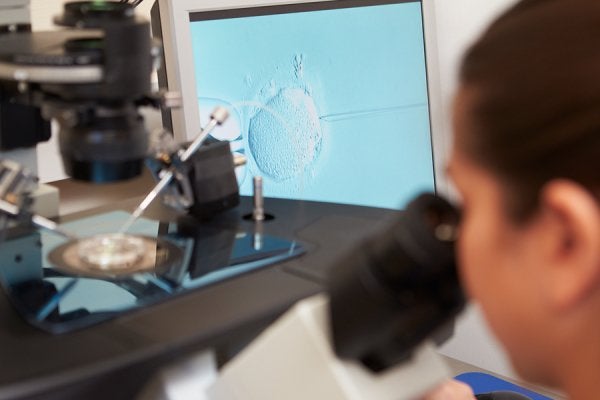-
Exploring Techniques for Sperm Retrieval for IVF

When it comes to child conception, men who are unable to produce sperm have an alternate option: sperm retrieval. To ensure successful impregnation, the methods of sperm retrieval are usually accompanied with in vitro fertilization (IVF) and intracytoplasmic sperm injection (ICSI). Sperm retrieval can be achieved with any one of the following procedures provided by visiting Dr. Green in Sarasota:
Testicular sperm extraction (TESE)
This male infertility option involves an incision of the testes, under anesthesia, so that sperm can be extracted for an IVF with ICSI.
Testicular sperm aspiration (TESA)
This procedure is alternately known as a testicular fine needle aspiration (TFNA) ; it involves a needle and syringe, which are used to extract sperm straight from the testis without a standard incision of the scrotum.
Percutaneous epididymal sperm aspiration (PESA)
This infertility procedure involves withdrawing fluid from the epididymis with a needle and syringe. Despite its lower success rate, the method is an easy, low-cost option for the more challenged candidates, such as vasectomized men who also happen to have azoospermia (low sperm counts).
Microsurgical epididymal sperm aspiration (MESA)
Another option for men with obstructive azoospermia, this involves the extraction of fluid—through aspiration or incision—from the epididymal tubules with a syringe and microscope.
Microsurgical testicular sperm extraction (Micro-TESE)
Strictly for candidates without obstructive azoospermia, this method studies and compares normal and abnormal areas of sperm activity in the testis, which are opened at the outer layer under a microscope.
If you would like to experience fatherhood again, years after having had a vasectomy, contact the Center for Vasectomy Reversal in Sarasota. We have helped many middle-aged and older men regain their ability to conceive years after their vasectomies, and you can learn more about our services by visiting our website or calling (941) 981-4341 to schedule an appointment with Dr. Green, our vasectomy-reversal surgeon.
-
What is the TESE Procedure?

If you produce ejaculate without sperm, your doctor may recommend sperm retrieval in conjunction with in vitro fertilization (IVF) and intracytoplasmic sperm injection (ICSI) for reasonable pregnancy rates. Sperm can be retrieved from the reproductive tract by various approaches, including testicular sperm extraction (TESE). The TESE procedure is used to diagnose the cause of a man’s azoospermia (absence of sperm in the ejaculate fluid) and obtain sufficient tissue for sperm extraction. TESE involves one or multiple microscopic incisions in the testicles. For the best success rate, consult with a male infertility and vasectomy reversal surgeon that utilizes the latest microsurgical technologies and techniques.
TESE is just one of the many sperm retrieval procedures performed by Dr. Joshua Green and the Center for Vasectomy Reversal and Male Infertility in Sarasota. The sperm retrieval process typically varies from a few minutes to a couple of hours, depending on the technique or procedure being performed by your male infertility surgeon.
-
Reasons Your Fertility Doctor May Recommend Sperm Retrieval

If you have been diagnosed as infertile, there may still be hope for you to become a father. Sperm retrieval procedures (testicular sperm extraction, testicular sperm aspiration, microsurgical/percutaneous epididymal sperm aspiration, etc.) in conjunction with in vitro fertilization can help couples achieve reasonable pregnancy rates. If you have reached out to a fertility doctor in Sarasota , sperm retrieval may be one of the recommended procedures to obtain sperm for fertility purposes. There are a few specific reasons why your doctor may recommend sperm retrieval, including:
Obstructive Azoospermia
Azoospermia is the absence of sperm in the ejaculate fluid. If sperm are produced by the testicles but are unable to be released into the semen, there may be a blockage in the reproductive tract. Common causes of obstructive azoospermia include a genetically missing vas deferens or injury to the vas deferens from previous surgery, such as a vasectomy or hernia repair. If you are going in for a vasectomy removal, your vasectomy reversal surgeon will inspect the condition of the vas deferens.
Non-Obstructive Azoospermia
Non-obstructive azoospermia is a condition in which sperm are either not being produced at all or are being produced in such low level that there is not enough of them to reach the end of the reproductive tract. Your doctor will recommend blood tests and genetic tests to determine the cause of non-obstructive azoospermia before continuing with the recommended sperm retrieval procedure.
Anejaculation/Retrograde Ejaculation
If no semen is released from the tip of your penis after having an orgasm, this may be caused by anejaculation or retrograde ejaculation. Anejaculation refers to no seminal fluid being released from the reproductive tract into the urethra, while retrograde ejaculation refers to semen being released into the urethra but being pushed backwards into the bladder. Injuries and certain types of medical conditions are commonly responsible for preventing the body from being able to ejaculate semen out of the reproductive tract.
Recent Posts
Popular Posts
categories
- Uncategorized
- Sperm Retrieval
- vasectomy reversal
- Emergency
- Dr. Green
- sperm count
- fertility
- male infertility
- MESA
- medical care
- low sperm count
- IVF
- male fertility testing
- anesthesia
- pregnancy
- sperm aspiration
- semen analysis
- post-vasectomy pain syndrome
- infertility
- VE
- anti-sperm antibodies
- older dad
- general anesthesia
- gender reveal party
- post-operative infections
- baby name
- parent
- baby's first year
- fertilization process
- spinal anesthesia
- ACS Fellow
- nutrition tips
- concierge-level care
- fertility planning app
- azoospermia
- out-of-town patients
- V-V
- post-vasectomy reversal
- conceiving
- vasectomy
- vasoepididymostomy
- smoking
- sperm quality
- baby registry
- infographic
- surgical care
- surgical consultation process
- prostate cancer
- baby gender
- family time
- COVID
- Baby Shower
- Child Care
- Halloween Costume Ideas for Babies
- Halloween
- Halloween Safety Tips
- Celebrity Infertility Spotlight
- Postpartum
- testosterone
- Father's Day
- Father
- Men's Health
- Thanksgiving
- Pregnancy Announcement
- Parenting Tips
- Sperm
